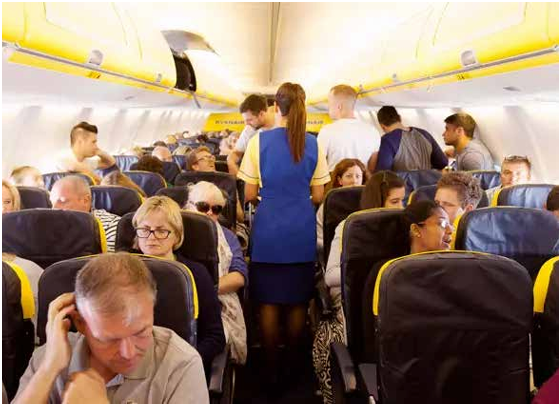
ENSURING SAFETY IN AIR TRAVEL:
THE IMPORTANCE OF EMERGENCY PREPAREDNESS AND EVACUATIONS
Air travel remains the safest form of transportation, thanks to a combination of well-maintained aircraft, trained flight crews, and rigorous safety protocols. While the chance of an emergency is minimal, knowing how to act in case one arises can make all the difference in ensuring passenger safety.
Air Travel: The Safest Mode of Transportation
Air travel remains the safest mode of transport, thanks to a robust aviation system that ensures aircraft are well-maintained and flight crews are properly trained. While commercial aviation operates with an exceptional safety record, emergency situations can occasionally arise. In such instances, being prepared and following established protocols can make a crucial difference in ensuring passenger safety.
Although the likelihood of an emergency evacuation is extremely low, it is essential for passengers to be aware of proper evacuation procedures. High-profile incidents, such as the 2009 Hudson River landing and the 2024 Haneda Airport accident, have demonstrated the effectiveness of emergency evacuations when passengers and crew adhere to established safety protocols. In both cases, all passengers and crew on the commercial aircraft were successfully evacuated without fatalities.
Understanding the key elements that contribute to a successful evacuation can help passengers stay prepared in the unlikely event of an emergency.
Passenger Responsibilities During an Evacuation
1. Pay Attention to Safety Briefings
Before every flight, cabin crew provide safety demonstrations, which detail emergency procedures. Even for frequent flyers, it is important to pay attention, as aircraft configurations and safety equipment vary by model. Additionally, reviewing the safety card provided in the seat pocket can reinforce important procedures.
If seated next to an emergency exit, passengers must listen carefully to the instructions provided by the cabin crew. Some emergency exits require passenger assistance in opening the door, making it critical to understand their operation.
2. Follow Crew Instructions
Cabin crew undergo rigorous training to handle emergency scenarios. In an evacuation, following their guidance is paramount. Flight attendants are trained to manage panic, coordinate movement, and ensure that emergency exits are used efficiently.
3. Secure Your Seatbelt During Critical Phases of Flight
During taxi, takeoff, and landing, seatbelts should be tightly fastened around the hips. This positioning provides maximum support in case of an impact. Even during cruise, keeping the seatbelt loosely fastened is advisable to prevent injuries from unexpected turbulence.
4. Leave Your Luggage Behind
Time is of the essence during an evacuation. Attempting to retrieve personal belongings not only slows down the process but also increases the risk of injury and may obstruct evacuation paths. Past incidents have shown that passengers attempting to carry luggage during evacuations can severely hinder the escape process, putting lives at risk.
Aircraft Design for Evacuation Safety
Aircraft manufacturers must adhere to strict certification requirements to ensure that aircraft can be evacuated swiftly and safely in an emergency. Several key design elements contribute to this:
1. Emergency Exits
Aircraft are equipped with multiple emergency exits, whose number and placement depend on the aircraft’s size and passenger capacity. These exits must be easily accessible, clearly marked, and simple to operate in an emergency.
2. Evacuation Equipment
Aircraft are equipped with various safety features to facilitate a successful evacuation, including:
Fire-resistant materials to minimize the spread of flames.
Smoke detectors and fire extinguishers for onboard fire suppression.
Emergency lighting systems to guide passengers even in low-visibility conditions.
Evacuation slides and rafts to enable rapid exits.
Crash-resistant seating to enhance passenger safety in the event of an impact.
Emergency oxygen systems to provide breathable air in case of cabin depressurization.
3. Evacuation Testing
Before an aircraft is certified, manufacturers must demonstrate that it can be fully evacuated within 90 seconds using only half of its exits. This stringent requirement ensures that passengers can evacuate in the shortest time possible. The tests are conducted under ideal conditions with physically capable volunteers, making real-life evacuations potentially more challenging.
Before every flight, the crew conducts meticulous safety inspections to ensure that all emergency equipment is fully operational. A common phrase heard during these procedures, “crosscheck complete,” signifies that another crew member has verified the necessary safety checks. These protocols are in place to maintain the highest safety standards, and passengers also play a role in this process by reporting any unusual occurrences, such as smoke in the cabin or visible damage to the aircraft.
Seating arrangements are another important consideration in ensuring passenger safety. Airlines strategically place individuals with reduced mobility and families with young children in seats that allow for easier access to emergency exits. Keeping children seated with their guardians enhances their ability to receive assistance when needed, improving overall emergency preparedness.
Although emergencies in commercial aviation are rare, preparedness remains a key factor in ensuring safe outcomes. Listening to safety briefings, following crew instructions, wearing seatbelts properly, and leaving personal belongings behind during evacuations all contribute to a swift and efficient response. The aviation industry remains steadfast in its commitment to safety through continuous training, advanced aircraft technology, and strict regulatory standards, ensuring that air travel continues to be the safest mode of transportation worldwide.